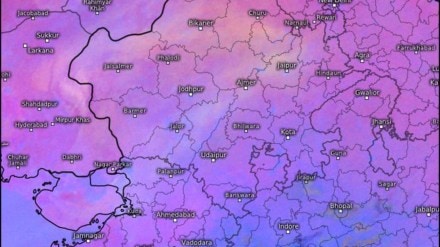Volcanic ash DGCA advisory: The Directorate General of Civil Aviation (DGCA) on Monday issued a strict advisory to all Indian airlines after a massive ash cloud from Ethiopia’s Hayli Gubbi volcano drifted into Indian airspace. The volcano erupted on Sunday for the first time in over 12,000 years, recording an ash plume nearly 45,000 feet high, moving northeast at 100–120 km per hour.
A sulphur dioxide–filled ash plume is drifting over Delhi-NCR, Haryana, and parts of Uttar Pradesh, according to IndiaMetSky Weather. Mumbai’s Chhatrapati Shivaji Maharaj International Airport also issued a passenger advisory as the volcanic ash affects airspace over parts of West Asia.
Ash plume (In White) from #HayliGubbi Volcano eruption has entered Indian subcontinent. It will cross #Haryana #Delhi NCR #Chandigarh #UttarPradesh region over the next few hours and reach western #Himalayas overnight.
— Weatherman Navdeep Dahiya (@navdeepdahiya55) November 24, 2025
It is a mix of SO2 and mild volcanic ash content,… pic.twitter.com/ZlAonGOfvi
DGCA issues advisory after Ethiopia volcano eruption
The DGCA instructed Indian airlines to avoid flying through areas affected by volcanic ash, adjust flight routes and fuel planning, and report any encounters with ash immediately. Crews, dispatchers, and engineers were told to follow procedures from the Volcanic Ash Operations Manual.
The ash-filled clouds have already caused disruptions for several airlines. Air India Express cancelled its Kochi–Jeddah flight, while IndiGo cancelled its Dubai–Kochi operations.
At airports like Indira Gandhi International Airport, operations continued under strict monitoring. Airlines were directed to adjust their flight routes based on real-time updates to ensure safety.
According to DGCA guidelines, post-flight inspections of engines and aircraft are mandatory for planes operating near the affected regions. Airports within the affected trajectory were instructed to restrict, suspend, or adjust operations as needed.
The DGCA has also asked airlines to activate safety-risk assessments and follow international guidelines. An ASHTAM (a special warning issued only when volcanic ash becomes a risk) provides exact coordinates, altitudes, and movement forecasts, making it more urgent than a standard NOTAM. Strict compliance with these measures will continue until further notice.
Ash cloud reaches India
The thick ash cloud from the eruption was expected to reach Delhi, Punjab, and Haryana by Monday night. Small pockets of ash have also been detected over other parts of India. Airports are on alert, and passengers have been advised to check the status of their flights before travelling.
Air India said its flight operations are not affected at present. The airline is closely monitoring the situation. IndiGo also said that passenger safety is its top priority and that staff are present across airports to help travellers and track developments.
Akasa airlines released a statement, “We are closely monitoring the volcanic activity in Ethiopia and its potential impact on flight operations in nearby regions. Our teams will continue to assess the situation in compliance with international aviation advisories and safety protocols and take necessary actions as required. At Akasa Air, passenger safety and well-being are our utmost priority.”
Volcano erupts after 12,000 years
On Sunday morning, Ethiopia’s Hayli Gubbi volcano erupted for the first time in more than 12,000 years. The ash drifted west over the Red Sea toward Yemen, Oman, India, and parts of Pakistan. Locals said there was no record of the volcano erupting before. The Smithsonian Institution’s Global Volcanism Program confirmed that Hayli Gubbi had no activity in the Holocene period, which began around 12,000 years ago.
